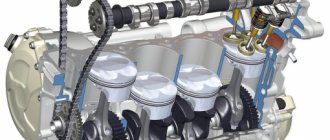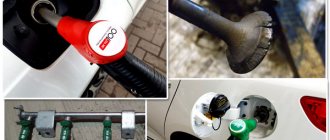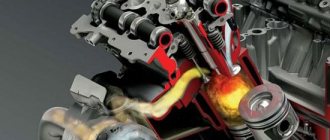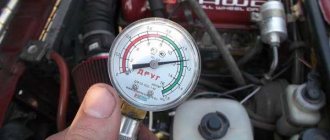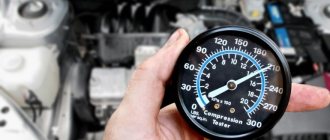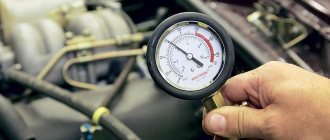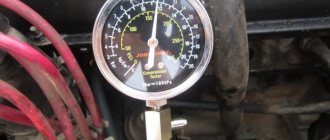People who study the design of vehicles equipped with an internal combustion engine often encounter concepts and terms that are incomprehensible to the average person.
The operation of a power plant is associated with a number of physical processes, and the internal combustion engine itself is replete with all kinds of symbols. The topic of our conversation today will be the concept of compression in the engine. Let's talk about what it is, and whether there is a difference in the compression of gasoline and diesel engines.
Compression and compression ratio
The concept of compression means an indicator of the maximum pressure inside the cylinder, the pressure created at the top point of the piston (the so-called “dead center”). Compression is measured in the following quantities:
- In Pascals (1 Ra = 1H per sq.m).
- In millimeters of mercury.
- In physical atmospheres, which corresponds to 360 mmHg.
- In technical atmospheres, which corresponds to 1 kgf/sq.cm.
- In bars.
When it comes to auto mechanics, compression is usually measured in atmospheres, less often in micropascals (abbreviated MPa).
Important
Compression in engine cylinders is a compression of gas that occurs under the influence of an external force in order to reduce the volume of gas, increase pressure and temperature.
To understand this phenomenon in detail, it is necessary to understand the structure of the motor, consisting of a valve, cylinder block, pistons and piston rings, crankshaft and connecting rods.
When the piston rises on the compression stroke, the valves are in the closed position. The fuel mixture ignites, and the pressure in the cylinder is at its maximum. The number reflecting the pressure indicator at this point in time is compression.
There are often cases when compression as a concept from physics is confused with the compression ratio, which is a mathematical value and reflects the ratio of the volume of the combustion chamber to the total volume of the cylinder. It, that is, the compression ratio, is measured as a fraction, for example, 1:12 or 1:20, etc.
As a rule, compression and compression ratio in internal combustion engines are the same, but there are exceptions, so it is impossible to talk about the identity of these concepts. The performance in turbocharged and forced power plants differs significantly.
Preventing pressure fluctuations
Regular diagnostics of the condition of the diesel engine will help to avoid deviations from the norm in performance. The change in pressure force itself is a symptom of the manifestation of problems or serious breakdowns.
Timely change of the oil filter and careful attention to the choice of the oil product itself help maintain the correct pressure in the system. You should not skimp on the quality and quantity of lubricant; such inappropriate tightness can lead to more serious losses.
Compression values in gasoline and diesel engines
Speaking about what compression should be in the engine, it is important to note that this value depends on what kind of engine we are talking about. The compression of a diesel engine can range from 14 to 18 and this will be the norm, while the compression of a gasoline engine ranges from 8 to 12.
But if we talk about the compression ratio, then on diesel units it cannot fall below 20:1; in the case of gasoline engines, the norm is considered to be in the range of 10:1 - 13:1.
Compression is influenced by many factors, in particular, the tightness of the connection between cylinders and pistons, cylinders and throttle valve, cylinders and valves. Novice car enthusiasts are concerned with the question of why they need to check engine compression.
The answer is simple: this is an indirect sign of a malfunction of the power plant, which may indicate the presence of serious problems in its operation. If you miss the moment, serious consequences are possible, including the need for a major overhaul of the internal combustion engine. Compression is measured using special devices - compression meters.
What should be the pressure in the cylinders?
For gasoline engines, the normal compression ratio is 9-11 and 12-13 kg/cm2, respectively; for diesel engines, the norm is 20 or more and 20-32 kg/cm2.
As you can see, the metrics are very different, and therein lies the difference in their workflow. Low ambient temperatures can be a serious problem. Different pressure ratings can provide starting at different temperatures:
- 28 kg/cm2 and below - starting the engine is possible at a temperature not lower than minus 15 degrees.
- 20-30kg/cm2 – temperature down to minus 20 degrees.
- 32 kg/cm2 – minus 20-25 degrees.
- 36 kg/cm2 – up to minus 30 degrees.
It should be noted that such temperature ranges on a diesel engine are only achievable with a fully operational power unit and auxiliary equipment.
Causes of compression loss
If the values obtained as a result of measurements are below normal, it is necessary to restore the required pressure in the cylinders. Otherwise, the problem will worsen and operation of the vehicle will be impossible.
The engine will stop starting, its speed will begin to “jump” during operation, and extraneous noise will appear. The power of the power plant will noticeably decrease, fuel consumption will increase, and the content of harmful impurities in the exhaust gases will increase. By the way, one of the main signs of low compression is blue smoke from the exhaust pipe that appears when the engine starts.
The most common causes of compression loss include:
- A burnt-out piston, valve or gasket on the cylinder block.
- The cylinder parts are noticeably worn and require replacement.
- The valve seat has collapsed.
The first thing to do if any of the signs described above is detected is to immediately go to a service station, take measurements and diagnose. If the preliminary “diagnosis” is confirmed, it is necessary to replace the faulty components and measure the compression again.
Causes and consequences
In order for the lubricant mixture to adequately cope with its tasks, its pressure in the engine must be stable and constant. Fluctuations in one direction or another have a detrimental effect on work and can lead not only to damage, but also to the complete failure of the heart of the machine.
High blood pressure
It is provoked by the following points:
- inadequate viscosity - the oil may be too thick, which will lead to difficulty in its circulation;
- defects in the pressure reducing valve - such a defect leads to the appearance of excess lubricant masses that are not removed from the system;
- blockages in filters and conductive elements provoke a decrease in permeability and an increase in pressure.
The consequence of such problems can be increased oil consumption, which escapes through oil seals damaged by excessive pressure and is discharged through the crankcase ventilation system. If oil gets on the idle speed control, it will cause a malfunction of the engine, and contact of the lubricant with the measuring element of the air flow sensor can completely damage the device.
The crankshaft counterweights foam excess oil, saturating it with gases, which leads to disruption of normal engine operation. In severe cases, such a malfunction leads to the destruction of the piston skirts.
Low pressure
The other extreme occurs for the following possible reasons:
- insufficient volume of oil product in the system - initially poor filling due to incorrect level measurement;
- lubricant leakage through damaged conductors and seals. It is determined visually - oily spots form under the car;
- low conductivity of the filtration system occurs due to valve damage, blockage, or the use of an unsuitable or defective model;
- damage to the oil pump - most often it is simply dirty, but complete failure is also possible;
- the consistency of the petroleum product is too liquid due to the ingress of coolant and fuel into it;
- natural wear and tear of the engine in old cars with high mileage.
As a result of the above anomalies, the entire engine suffers. If these troubles are not eliminated in time, you can damage the heart of the car so much that you will have to replace it with a new one.
How to measure compression
Above we talked about what engine compression is considered normal. Now we will give some tips on how to independently carry out the relevant measurements.
Let us remind you that professional mechanics measure this value using a special device - a compression meter, which is easy to find on the open market. So, “armed” with the mentioned device, which is actually a regular pressure gauge with a check valve, we do the following:
We check the battery charge, because while measurements are being taken, the engine is running on the battery. We warm up the engine in advance so that it reaches operating temperature (this is the only way to get the most accurate result).
The measurement process itself consists of the following stages:
- Removing wires from all spark plugs.
- Unscrewing the spark plug on each cylinder.
- Pulling out the fuel pump if it is electric. (In cases with a conventional fuel pump, it is necessary to remove the hose that supplies fuel from it).
- Disconnecting the electrical wire from the injectors.
You can start measuring. It is best to do this with an assistant, because one person must rotate the engine, and the second must record the results. In order for the measurements to be correct, the compression meter must be connected to the cylinder that is being checked at a specific point in time.
Next, the accelerator pedal must be pressed to the maximum - this will ensure full opening of the throttle valve. The ignition key is turned and the starter begins to rotate. You need to act until the values recorded by the device stop increasing, they become the real compression of the engine.
Upon completion of the measurements, the obtained indicators must be compared with the norm (it is indicated in the vehicle operating instructions). If the numbers are the same, or they differ insignificantly, the cause of the malfunction lies in something else.
Normal pressure
To correctly determine the norm of oil pressure indicators, you need to understand that measurements must be carried out in two ways:
- at idle - around 2 bar or 0.2 MPa;
- at high speeds - from 4 to 7 bar.
Please note that the operating manuals must indicate the parameters corresponding to the specific model. Having identified a non-compliance with these standards, it is necessary to take emergency measures to eliminate this dangerous defect.
How to restore compression
If the compression is low, the most common cause is a loss of seal, and in this situation it is important to determine where the leak occurred. To do this, about 50 ml is poured into the cylinder on which suspicion has fallen. oil and measure again. If the data remains the same, it means that the air is coming out higher, possibly in the combustion chamber. If the result is different, the cause of the malfunction lies in stuck piston rings.
If there are noticeable differences between the existing value and the one that is the norm for a particular motor, major repairs cannot be avoided. If the difference is small, the compression is increased with special additives. If they helped, great; if not, you’ll have to entrust the car to experienced mechanics.
It is noteworthy that much depends on whether the pressure has dropped in one or all cylinders at once. In the first case, you can do without repairs, and just clean the combustion chamber of deposits. When compression has dropped in all cylinders, the car is on its way to the service station.
Measurement technique
To measure the compression of a diesel engine, you will need some special equipment.
When taking measurements, you will need a compression gauge - a version of a pressure gauge adapted to measure the pressure inside the cylinders. How to measure compression? The work consists of the following stages:
- First you need to remove the glow plug or injector on one of the cylinders.
- Instead, a pressure gauge fitting is screwed in.
- The crankshaft is rotated using the starter, at which time the pressure readings are recorded. The starter must provide at least 200 rpm.
- The pressure gauge is disconnected and the check is carried out similarly in all other cylinders. Normally, the measurement results should be approximately the same in all cylinders.
- The spark plugs or injectors are unscrewed again and 50 ml of engine oil is injected into each cylinder through the hole.
- The engine is cranked by the starter with the spark plugs or injectors removed. After this, the compression in all cylinders is checked again.
Before measuring the compression of a diesel engine, it must be warmed up to operating temperature.
If the indicator has changed upward, it means that parts of the connecting rod and piston group in the cylinders of the diesel engine are wearing out.
If the compression indicators are the same, then the gas distribution mechanism (valve thermal clearances) should be adjusted.
After making the necessary adjustments, it is necessary to check the compression again and troubleshoot the auxiliary equipment.
Car Forums POKATILI.RU
| Current time: Tue Sep 07, 2022 17:37 |
Time zone: UTC + 4 hours [Summer Time]
Diesel engine compression ratio
Well, you just asked for it, I hope we’ll give you a special title on this occasion

